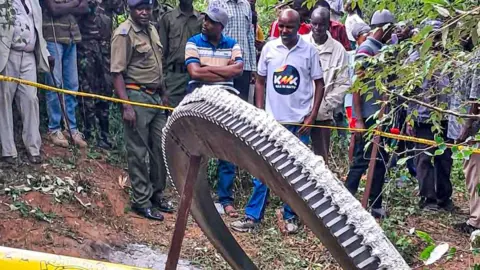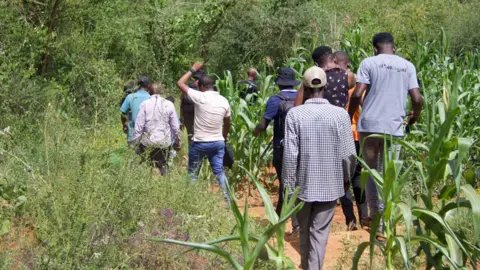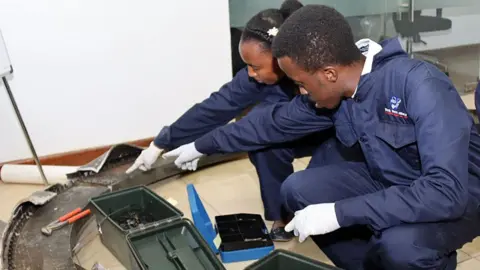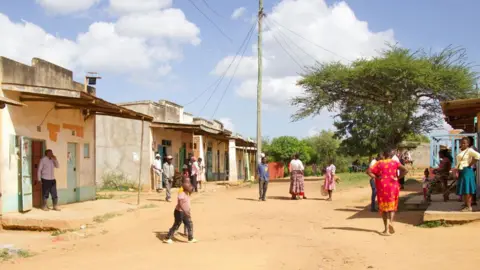 Getty Images
Getty ImagesAn eerie whistling sound followed by a loud noise startled Kenyan villagers relaxing one recent afternoon with family and friends.
“It sounded like a bomb, I was shocked. I started looking around, also wondering if it was gunshots,” Stephen Mangoka, a 75-year-old farmer from Mukuku village in Makueni district, told the BBC.
“I looked at the sky to see if there was smoke. Nothing.
“I rushed to the road to check if there was an accident. Also nothing. Then someone told me something fell from the sky.”
In fact, a massive round metal object fell from above and landed on farmland near a dry riverbed – and it was hot.
“We found a large piece of metal that was very red so we had to wait for it to cool before anyone could go near it,” said Ann Kanuna, who told us she owns the land where the object fell.
It took about two hours for the giant ring to cool down and turn gray – but it has already become a real sensation with people coming to see it.
For the rest of that Monday afternoon – with few people working like the day before New Year’s Eve – crowds came to see the giant metal ring.
It was like a selfie in the center, with people coming to pose next to it and great debate about what it could be.
Local authorities in Makueni district – which is about 115 km (70 miles) southeast of the capital Nairobi – were notified.
The Kenya Space Agency (KSA) then heard about it and arranged to come and explore the next day.
But the item was so famous that Mukuku locals feared it would be stolen overnight.
Together with the local officers, some of them took turns standing guard, lighting a fire nearby. They wanted to keep out potential scrap dealers and others who want to make money off of curiosity.
It is said to weigh more than 500 kg (1,102 lb) – about the same as an adult horse – and is about 2.5 m (8 ft) in diameter, about the size of a child’s four-seater carousel.
With daylight came more observers on New Year’s Eve – accompanied by the KSA team and the media.
 Peter Njoroge/BBC
Peter Njoroge/BBCMukuku had never seen such activity. When the item was taken away by the KSA later that day, murmurs gave way to concern about what the peasants had in their midst.
KSA said its preliminary assessments show the object is a “separation ring” from a space launch rocket.
“Such objects are typically designed to burn up when re-entering the Earth’s atmosphere or to fall in uninhabited areas, such as oceans,” it said in a statement the next day.
No one was injured when it fell, but some in Mukuku began to complain that the impact caused damage to nearby houses.
Christine Kionga, who lives about a kilometer from the accident site, showed us cracks in the concrete of some of the buildings in her house. She said they appeared after the accident.
Other neighbors claimed the structural integrity of their homes was also compromised – allegations that have yet to be substantiated.
“The government must find the owners of this facility and get compensation for those affected,” Mukuku resident Benson Mutuku told the BBC.
There were reports in the local media that some residents had begun to complain of feeling unwell after being exposed to the metal ring, although there was no confirmation from those we spoke to when we visited – nor from the authorities or the KSA.
Nevertheless, Mr. Mutuku said there were concerns about the long-term effects of possible space radiation.
“This is a space facility and we have heard in other similar incidents that there have been radiation effects that have affected even future generations and there is that fear in this community.”
However, tests later carried out by the Kenya Nuclear Regulatory Authority revealed that although the metal ring had higher levels of radiation than the area where it was found, it was not at a level harmful to humans.
 Peter Njoroge/BBC
Peter Njoroge/BBCEngineers from the KSA, which was established in 2017 to promote, coordinate and regulate space-related activities in the East African nation, continue to conduct other tests to learn more about the facility.
The general director of KSA said that it was lucky that no significant damage was done when the object fell to Earth.
“The ultimate responsibility for any damage or injury caused by that space object rests with the country under whose jurisdiction that operator launched the object,” Brigadier Hillary Kipkosgey told the BBC.
Under the Outer Space Treaty, overseen by the UN Office for Outer Space Affairs, “States are responsible for damage caused by their space objects.”
“(The ring) is a common thing in many rockets and many space objects so it is difficult to attribute it to a specific rocket or space object, but we have clues, but as I said, our investigations are not final,” said Brigadier Kipkosgey.
The BBC showed images of the object to the UK Space Agency to get the views of its experts.
“The most likely object it could be is the upper stage separation ring from the 2008 Ariane rocket,” said launch director Matt Archer.
“The satellites are fine, but the real body of the rocket has passed and de-orbited.”
Ariane was Europe’s main rocket launcher, helping more than 230 satellites into orbit, before it was decommissioned in 2023.
It appears that the separation ring may have been orbiting Earth for 16 years before it unexpectedly appeared in Mukuku.
This is not the first incident of space junk to appear in East Africa.
A little over a year and a half ago, some space debris fell over several villages in western Uganda.
And a few days ago, on January 8, there were unconfirmed reports of what was believed to be space debris burning brightly in the sky over northern Kenya and southern Ethiopia.
 Peter Njoroge/BBC
Peter Njoroge/BBCAs the space industry grows, such incidents are predicted to become more common – and African governments may need to invest in ways to better detect this fast-moving space junk.
NASA estimates that there are more than 6,000 tons of space debris currently in orbit.
There are many different estimates of the chances of such garbage hitting someone, but most are in the one in 10,000 range.
Such statistics are of no comfort to the residents of Mukuku, who cannot help but think of the damage the ring could have caused if it had fallen in the center of the village instead of on farmland.
“We need assurances from the government that this will not happen again,” Mr Mutuku said.
You may also be interested in:
 Getty Images/BBC
Getty Images/BBC
